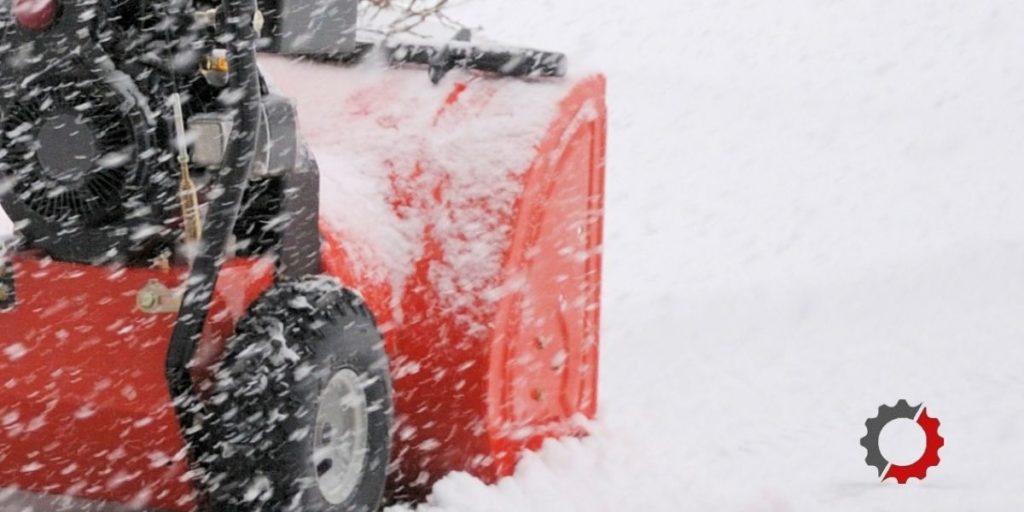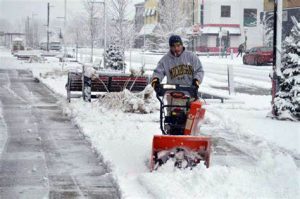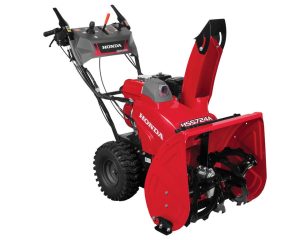This is Why Your Ariens Snowblower Starts Then Dies: SOLVED
Being stuck in the middle of a snowstorm when your Ariens snowblower dies is beyond frustrating. You rely on your snowblower to keep your sidewalks and driveway clear. Without it, you’re stuck using a hand shovel which makes your snow-clearing task increasingly more difficult.
An Ariens snowblower starts and then dies when fuel or air is restricted by old fuel, clogged fuel lines, a bad fuel pump, a dirty carburetor, or a clogged fuel filter. A bad spark plug, faulty ignition coil, or insufficient engine oil level can also cause an Ariens snowblower to quit after running.
Keep reading for additional items that can make your snowblower die after it’s been running a while. Stay safe and follow the safety precautions listed in the operator’s manual for your model Ariens snowblower.

This post may include affiliate links. Purchases made through these links may provide a commission for us, at no extra cost to you. As an Amazon Associate, we earn from qualifying purchases.
Follow all safety instructions provided in your equipment operator’s manual prior to diagnosing, repairing, or operating.Consult a professional if you don’t have the skills, or knowledge or are not in the condition to perform the repair safely.
Table of Contents
9 Reasons Your Ariens Snowblower Starts Then Dies
Bad or Old Gas in Your Ariens Snowblower
Gasoline sitting around for a while can begin to break down as quickly as 30 days after purchase. The ethanol found in most gasoline attracts moisture to the fuel system corroding components and leaving behind gummy deposits that restrict the fuel flow.
When the gas sits long enough, the ethanol and water mix will separate from the gas and sink to the bottom of the fuel tank.
This mix will cause the engine to run very hot and potentially damage the engine when it is run through it. Because of the damage ethanol can cause to the fuel system and engine, never use gas with more than a 10% ethanol content.
Both 2-cycle and 4-cycle Ariens snowblowers require an unleaded gas with a minimum 87-octane rating and a maximum 10% ethanol content. However, snowblowers with a 2-cycle engine require premium 2-cycle oil to be added to the gas.
If you find you are running old fuel, empty the fuel tank using a fuel siphon. Add fresh fuel with an additive mixed in to stabilize the gas to make it last longer without breaking down.
I choose to use Sea Foam for this purpose because it stabilizes the fuel system while reducing moisture and cleaning it too.
Ethanol-free fuels are best to run through your Ariens snowblower, but it is also the most expensive fuel choice. You can find ethanol-free fuel sold at select fuel stations sold as recreation fuel (REC-90).
You can also purchase ethanol-free fuel in ready-to-use canisters at your local hardware store or online.
4-Cycle Engine Fuel: TruFuel 4-Cycle Fuel
2-Cycle Engine 40:1 Premix: TruFuel 2-Cycle 40:1 Pre-Blended Fuel
2-Cycle Engine 50:1 Premix: TruFuel 2-Cycle 50:1 Pre-Blended Fuel
Read more about the best type of fuel to use in an Ariens snowblower, the right 2-cycle gas-to-oil ratio, and how to care for your fuel in “This is the Type of Gas Ariens Snowblowers Use“.
Plugged Fuel Filter on Your Ariens Snowblower
If you have a fuel filter installed on your Ariens snowblower, it can clog causing your engine not to get enough fuel. A filter can become plugged from running dirty old fuel.
Moisture may also get into the filter and freeze restricting the amount of fuel able to pass through the filter. Replace a plugged fuel filter.
Clogged Fuel Lines on Your Ariens Snowblower
Check the fuel lines on your Ariens snowblower. They may have become clogged with deposits left behind by old gas.
These deposits will prevent a sufficient amount of fuel to flow through the line. You will also need to look for kinked fuel lines.
Use the fuel shut-off valve located near the bottom of your fuel tank to stop and start fuel flow while you check each section of the fuel line. Use pinch pliers to crimp the fuel line to stop fuel flow if you don’t have a valve.
To check the flow out of a line, turn off the fuel supply, remove the end of the fuel line from a fuel components and place it in a container.
(Make sure the container is placed lower than the fuel tank because fuel can’t run uphill without the assistance of a fuel pump).
Turn on your fuel supply and confirm you have a good flow of fuel coming from the fuel line. If you don’t, you must shut off the fuel supply and remove the fuel line to be cleaned.
With the fuel line removed from your Ariens snowblower, spray carburetor cleaner into the line to loosen the clog. Follow this by blowing compressed air into the line to dislodge and remove the clog.
Repeat as necessary until the line is no longer clogged. Reinstall the fuel line if you are able to remove the clog. If not, replace it with a new fuel line.
When purchasing a fuel line, make sure you get the same size diameter and length of fuel line as the line you have removed. You will most likely have to cut down the fuel line length to fit.
Dirty Carburetor on Your Ariens Snowblower
A dirty carburetor is a common reason why an Ariens snowblower will begin to bog down and die. The carburetor is designed to regulate the amount of gas that gets mixed with air to form a combustion in the engine.
Old gas leaves behind a gummy substance that can cause the fuel jet to become clogged and the carburetor’s small components to stick so it no longer functions properly.
Before removing your carburetor, confirm you are getting fuel to the carburetor. If not, check the fuel filter, fuel lines, and fuel pump.
If you are not very mechanically inclined, you should bring your Ariens snowblower to a repair center. If you are mechanically inclined and don’t mind working with small parts, then follow the instructions below to clean your carburetor.
12 Steps to Identify and Clean Your Dirty Ariens Carburetor
- Spray carb cleaner to minimize carbon buildup. Spray some carb cleaner in the air intake. Start the engine to see if it will run. If the snowblower fires up and still won’t stay running, then we need to get inside the carburetor.
- Gather pliers, screwdrivers, sockets, and ratchets so you don’t destroy parts while taking the carburetor apart.
- Take a photo for reassembly. These days most people have a handy camera on their phones. It’s a very good idea to take a picture of the carburetor so you can refer to it if you don’t remember how to reassemble it after tearing it apart. You will want to make sure you get a photo showing how the linkage and springs go back on the carburetor.
- Remove the throttle cable and choke cable if your snowblower has one.
- Undo the filter housing and nuts or screws that hold the carburetor.
- Slowly remove the springs so you don’t stretch them out too much. You may have to twist the carb a bit to get the springs off. Also, watch the gasket at this point so you don’t tear it. This is the gasket located between the engine block and the carburetor.
- Remove the bottom screw from the float bowl. The float bowl is where gasoline is stored inside the carburetor. It should have gas in it so have a rag ready to catch the gas.
- Remove the bowl being careful to not damage the o-ring around it. Caution: Do not get any carb cleaner or any other chemical on the o-ring. It will stretch out and you won’t be able to reuse it.
- Inspect the stem for clogged holes. This stem hangs down from the center of the carburetor and has holes in it. If these holes get plugged from old fuel it will not draw fuel up to the jet. If the holds are plugged, take a thick wire to clean them out. It’s easier to see what you’re doing if you use a flashlight. Once you get the holes clean you can rinse them with carb cleaner.
- Inspect the carburetor for hard crusty white buildup. This white buildup is fuel additives including ethanol. You need to try to get as much of the white power material out as you can. It’s nearly impossible to get it all out.
- Reassemble the carburetor now that the carb is clean. Put it back to together in the reverse order you took it apart. Remember to refer to the photo you took of the carburetor when reassembling so all parts are reinstalled in the right places.
- Add fresh fuel that contains a fuel stabilizer before you start your snowblower. Pour the fuel into the tank and give it a chance to fill the bowl of the carburetor. Start your engine. If you are starting with a pull cord, give the rope a yank.
It may not start on the first pull, but it should start after several pulls and continue to run. If the carburetor does not work after cleaning it, you will need to rebuild it or replace it with a new one.
Dirty Spark Plug on an Ariens Snowblower
A fouled spark plug can make the plug fire intermittently causing your Ariens snowblower to run sluggishly and die. Remove the spark plug and check it for oil, dirt, and carbon buildup.
You can attempt to clean a dirty spark plug with a wire brush and reuse it.
I prefer to replace the plug with a new one since it plays an important role in a good running snowblower. It’s also a relatively inexpensive part.
You must also make sure the spark plug is gapped according to the engine manufacturer’s specifications and securely attach the spark plug wire (spark plug boot). These items can also cause your Ariens snowblower to stop running.
Insufficient Oil in Your Ariens Snowblower Engine
When there is too much oil in your Ariens snowblower the engine may smoke, run terribly, and eventually shut down. Too much engine oil can get up to your spark plug, into your cylinder, and hydro lock your engine.
- 2 cycle engine: Running more oil in the gas-to-oil mix required by your engine must be corrected. Drain the fuel and fill with the correct gas-to-oil mix.
- 4 cycle engine: Correct the engine oil level by draining a little oil either through the drain plug or with a turkey baster or oil extractor pump.
When you don’t run enough oil in your Ariens snowblower, you will also have problems.
An Ariens 2-cycle snowblower without enough oil mixed with gas or an Ariens 4-cycle snowblower without enough engine oil won’t provide enough lubrication for the internal engine parts to move smoothly which can result in significant engine damage.
To avoid problems that can develop from running your Ariens snowblower with the wrong amount of oil, make sure you are mixing the right about of oil with the right amount of gas in a 2-cycle engine.
Check your 4-cycle engine’s oil level before each use.
Bad Ignition Coil on Your Ariens Snowblower
The ignition coil can cause your snowblower to not stay running. The windings on the ignition coil can separate and short out when the snowblower gets hot.
This will result in the spark plug not being able to create spark because it is unable to get the voltage it needs. Check for a break in the continuity using an ohm meter.
Bad Gas Cap on Your Ariens Snowblower
If you’ve checked everything else and you still can’t find the reason your Ariens snowblower starts and then quits, the problem can be in the gas cap.
The gas cap is designed to vent allowing air to pass through the cap. When the vent gets plugged, the fuel tank will act like a vacuum. It restricts fuel from flowing out of the tank.
To confirm whether or not your gas cap is bad, start and run your snowblower with and without the cap. When your Ariens snowblower quits and won’t start, remove the cap and try to start it.
If it starts because the fuel tank now has access to air, allow the snowblower to continue to run while you reinstall the gas cap.
If the snowblower shuts down again after running for a while and then immediately starts once you remove the gas cap again, your dying problem is most likely the fault of the gas cap. Purchase and install a new Ariens snowblower gas cap.
Incorrect Choke Setting on an Ariens Snowblower
The choke restricts airflow to allow a higher concentration of fuel into the combustion chamber when starting a cold engine. Once the engine is warm, the choke must be adjusted to allow air to mix with fuel to continue to run.
When the choke lever isn’t adjusted correctly after the snowblower warms up, the snowblower will sputter and stop running because it isn’t getting sufficient airflow.
Where is the Air Filter on Your Ariens Snowblower?
You’re searching for an air filter. You may be thinking it’s in a really good hiding place on your snowblower or it has fallen off. There’s no need to keep looking. An Ariens Snowblower does not use an air filter.
Since the Ariens snowblower is designed to be used in the winter when the conditions are not dusty, there isn’t a need for an air filter.
A filter is also not used because water and ice conditions can build up in the filter and cause a snowblower to run sluggishly and shut off.






